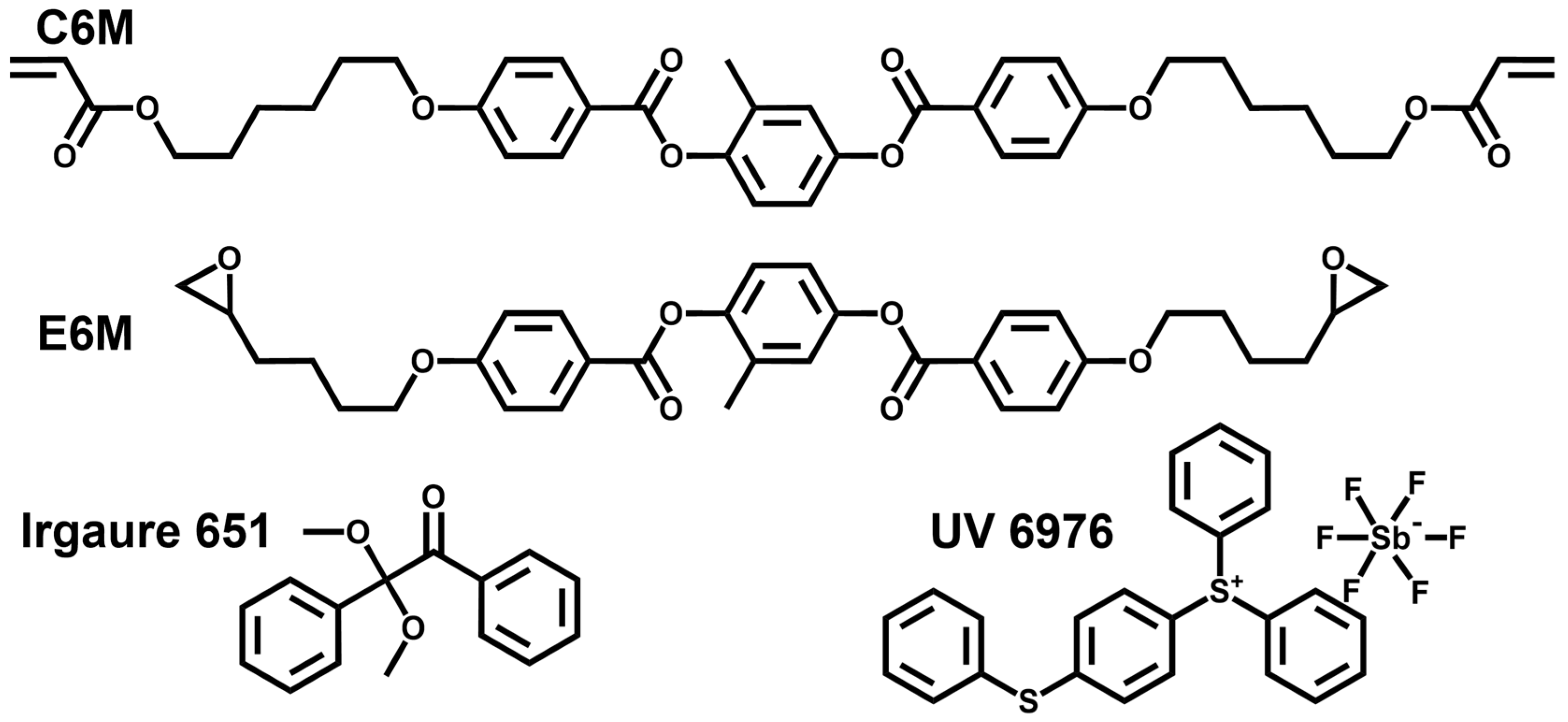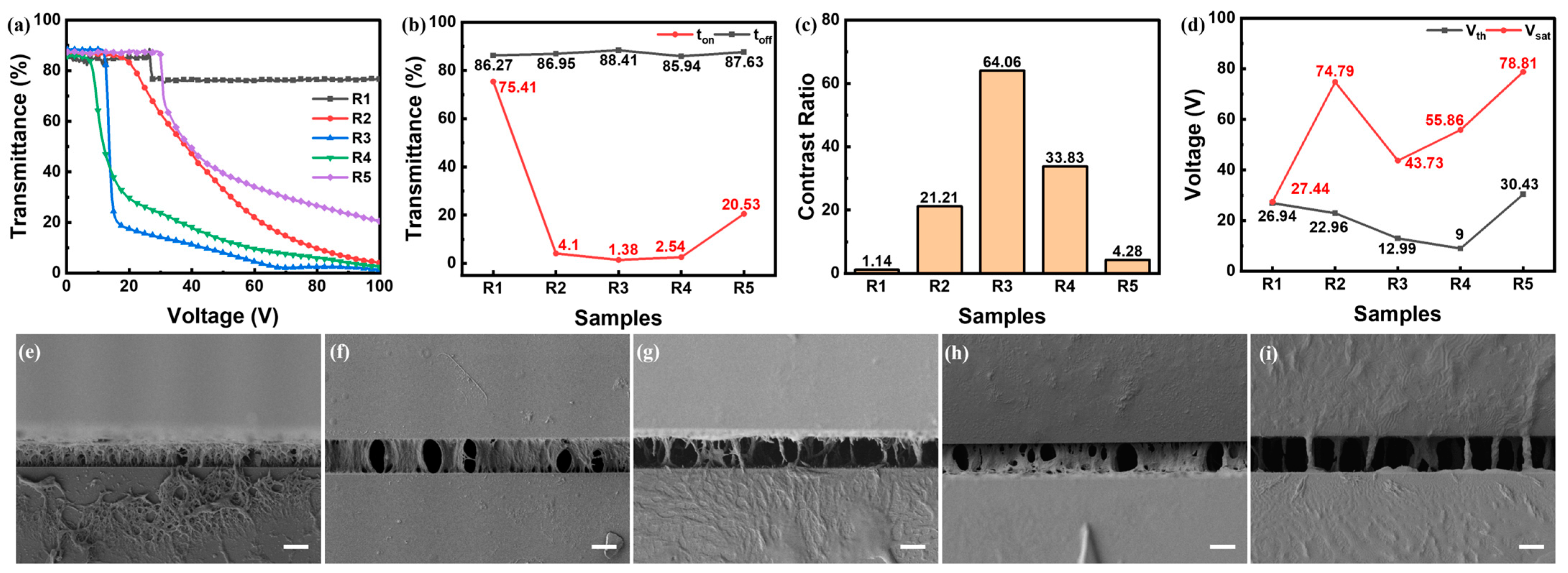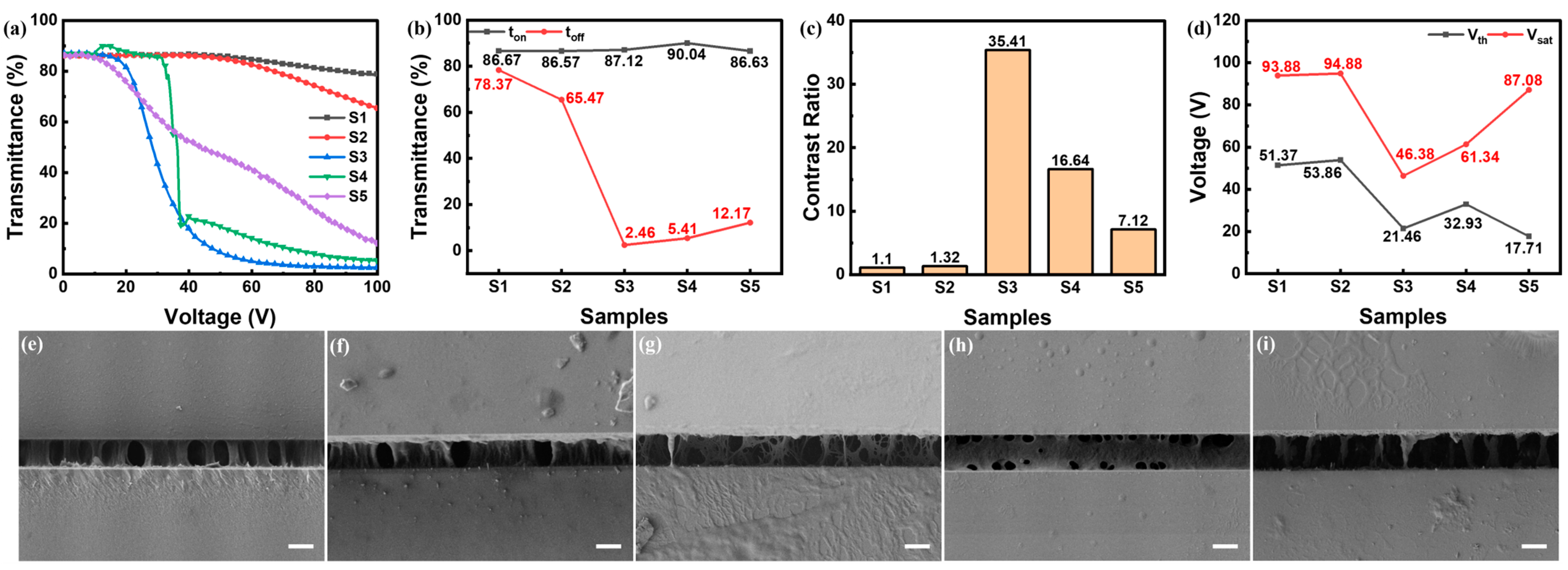Study on the Polymer Morphology and Electro-Optical Performance of Acrylate/Epoxy Resin-Based Polymer-Stabilized Liquid Crystals Based on Stepwise Photopolymerization
Abstract
:1. Introduction
2. Materials and Methods
2.1. Materials
2.2. Sample Preparation and Measurement
3. Results and Discussion
3.1. The Impact of the Photopolymerization Condition on the Polymer Morphology and E-O Properties
3.2. The Impact of Mass Ratios between C6M and E6M on Polymer Morphologies and E-O Properties
3.3. The Impact of Polymer Content on the Polymer Morphology and E-O Properties
4. Conclusions
Supplementary Materials
Author Contributions
Funding
Institutional Review Board Statement
Data Availability Statement
Conflicts of Interest
References
- McGlade, C.; Ekins, P. The geographical distribution of fossil fuels unused when limiting global warming to 2 °C. Nature 2015, 517, 187–190. [Google Scholar] [CrossRef]
- Kammen, D.; Sunter, D. City-Integrated Renewable Energy for Urban Sustainability. Science 2016, 352, 922–928. [Google Scholar] [CrossRef] [PubMed]
- Rezaei, S.; Shannigrahi, S.; Ramakrishna, S. A Review of Conventional, Advanced, and Smart Glazing Technologies and Materials for Improving Indoor Environment. Sol. Energy Mater. Sol. Cells 2017, 159, 26–51. [Google Scholar] [CrossRef]
- Nundy, S.; Mesloub, A.; Alsolami, B.; Ghosh, A. Electrically actuated visible and near-infrared regulating switchable smart window for energy positive building: A review. J. Clean. Prod. 2021, 301, 126854. [Google Scholar] [CrossRef]
- Rebecca, N.; Reinhart, W.; Gevaudan, J. Smart cities built with smart materials. Science 2021, 371, 1200–1201. [Google Scholar]
- Ke, Y.; Chen, J.; Lin, G.; Wang, S.; Zhou, Y.; Yin, J.; Lee, P.; Long, Y. Smart Windows: Electro-Thermo-Mechano-Photochromics, and Beyond. Adv. Energy Mater. 2019, 9, 1902066. [Google Scholar] [CrossRef]
- Amasawa, E.; Sasagawa, N.; Kimura, M.; Taya, M. Design of a New Energy-Harvesting Electrochromic Window Based On an Organic Polymeric Dye, a Cobalt Couple, and Pprodot-Me2. Adv. Energy Mater. 2014, 4, 1400379. [Google Scholar] [CrossRef]
- Meng, W.; Kragt, A.; Gao, Y.; Brembilla, E.; Hu, X.; de Burgt, J.; Schenning, A.; Klein, T.; Zhou, G.; de Ham, E.; et al. Scalable Photochromic Film for Solar Heat and Daylight Management. Adv. Mater. 2024, 36, 2304910. [Google Scholar] [CrossRef] [PubMed]
- Santos, A.; Martin, N.; Jiménez, J.; García, R.; Morales, F. Enhancing luminous transmittance and hysteresis width of VO2-based thermochromic coatings by combining GLAD and RGPP approaches. Constr. Build. Mater. 2024, 419, 135472. [Google Scholar] [CrossRef]
- Yu, Z.; Yang, Y.; Shen, C.; Mao, L.; Cui, C.; Chen, Z.; Zhang, Y. Thermochromic hydrogels with an adjustable critical response temperature for temperature monitoring and smart windows. J. Mater. Chem. C 2023, 11, 583–592. [Google Scholar] [CrossRef]
- Shen, W.; Zhang, H.; Miao, Z.; Ye, Z. Recent Progress in Functional Dye-Doped Liquid Crystal Devices. Adv. Funct. Mater. 2023, 33, 2210664. [Google Scholar] [CrossRef]
- Zhang, H.; Miao, Z.; Shen, W. Development of Polymer-Dispersed Liquid Crystals: From Mode Innovation to Applications. Compos. Part A Appl. Sci. Manuf. 2022, 163, 107234. [Google Scholar] [CrossRef]
- Shen, W.; Li, G. Recent Progress in Liquid Crystal-Based Smart Windows: Materials, Structures, and Design. Laser Photon. Rev. 2022, 17, 2200207. [Google Scholar] [CrossRef]
- Deng, Y.; Yang, Y.; Xiao, Y.; Zeng, X.; Xie, H.; Lan, R.; Zhang, L.; Yang, H. Annual Energy-Saving Smart Windows with Actively Controllable Passive Radiative Cooling and Multimode Heating Regulation. Adv. Mater. 2024, 36, 2401869. [Google Scholar] [CrossRef]
- Ghosh, A.; Norton, B.; Mallick, T. Daylight characteristics of a polymer dispersed liquid crystal switchable glazing. Sol. Energy Mater. Sol. Cell. 2018, 174, 572–576. [Google Scholar] [CrossRef]
- Hu, X.; Zhang, X.; Yang, W.; Jiang, X.; Jiang, X.; de Haan, L.T.; Yuan, D.; Zhao, W.; Zheng, N.; Jin, M.; et al. Stable and scalable smart window based on polymer stabilized liquid crystals. J. Appl. Polym. Sci. 2020, 137, 48917. [Google Scholar] [CrossRef]
- Dierking, I. Polymer Network-Stabilized Liquid Crystals. Adv. Mater. 2000, 12, 167–181. [Google Scholar] [CrossRef]
- Lin, X.; Li, Y.; Saravanakumar, S.; Tang, Q.; Zhang, S.; Gao, X. Sunlight-operable light converting smart windows for fertilizer-free plant growth enhancement. Nano Today 2020, 34, 100918. [Google Scholar] [CrossRef]
- Javad, K.; Navid, G. Thermal comfort investigation of stratified indoor environment in displacement ventilation: Climate-adaptive building with smart windows. Sust. Cities Soc. 2019, 46, 101354. [Google Scholar] [CrossRef]
- Li, H.; Xu, J.; Ren, Y.; Han, R.; Song, H.; Huang, R.; Wang, X.; Zhang, L.; Cao, H.; Zou, C.; et al. Preparation of Highly Durable Reverse-Mode Polymer-Stabilized Liquid Crystal Films with Polymer Walls. ACS Appl. Mater. Interfaces 2023, 15, 2228–2236. [Google Scholar] [CrossRef]
- Ranjkesh, A.; Yoon, T. Fabrication of a Single-Substrate Flexible Thermo-responsive Cholesteric Liquid-Crystal Film with Wavelength Tunability. ACS Appl. Mater. Interfaces 2019, 11, 26314–26322. [Google Scholar] [CrossRef] [PubMed]
- Liang, X.; Guo, C.; Chen, M.; Guo, S.; Zhang, L.; Li, F.; Guo, S.; Yang, H. A roll-to-roll process for multi-responsive soft-matter composite films containing CsxWO3 nanorods for energy-efficient smart window applications. Nanoscale Horiz. 2017, 2, 319–325. [Google Scholar] [CrossRef]
- Chen, G.; Hu, J.; Xu, J.; Sun, J.; Xiao, J.; Zhang, L.; Wang, X.; Hu, W.; Yang, H. Liquid Crystalline Composite Stabilized by Epoxy Polymer with Boscage-Like Morphology for Energy-Efficient Smart Windows with High Stability. Macromol. Mater. Eng. 2022, 307, 2100991. [Google Scholar] [CrossRef]
- Zhang, Y.; Zhan, Q.; Wang, C.; Gao, J.; Zhou, G.; Zhao, W.; Chen, J. Unique Polymer-Stabilized Liquid Crystal Structure Prepared by Addition of a Reversible Addition-Fragmentation Chain Transfer Agent. ACS Appl. Mater. Interfaces 2023, 15, 51815–51822. [Google Scholar] [CrossRef] [PubMed]
- Yoon, W.; Choi, Y.; Lim, S.; Koo, J.; Yang, S.; Jung, D.; Shin, W.; Jeong, K. A Single-Step Dual Stabilization of Smart Window by the Formation of Liquid Crystal Physical Gels and the Construction of Liquid Crystal Chambers. Adv. Funct. Mater. 2020, 30, 1906780. [Google Scholar] [CrossRef]
- Guo, S.; Liang, X.; Zhang, H.; Shen, W.; Li, C.; Wang, X.; Zhang, C.; Zhang, L.; Yang, H. An electrically light-transmittance-controllable film with a low-driving voltage from a coexistent system of polymer-dispersed and polymer-stabilised cholesteric liquid crystals. Liq. Cryst. 2018, 45, 1854–1860. [Google Scholar] [CrossRef]






| Content (wt%) | UV Process | |||||
|---|---|---|---|---|---|---|
| Samples | LC | E6M | C6M | Irg 651 | UV 6976 | |
| P1 | 91.6 | 4 | 4 | 0.2 | 0.2 | 25 mW/cm2, 10 min; 75 mW/cm2, 2 h |
| P2 | 91.6 | 4 | 4 | 0.2 | 0.2 | 75 mW/cm2, 2 h |
| Q1 | 91.6 | 4 | 4 | 0 | 0.2 | 25 mW/cm2, 10 min; 75 mW/cm2, 2 h |
| Q2 | 91.6 | 4 | 4 | 0 | 0.2 | 75 mW/cm2, 2 h |
| R1 | 89.8 | 2 | 8 | 0 | 0.2 | 75 mW/cm2, 2 h |
| R2 | 89.8 | 4 | 6 | 0 | 0.2 | 75 mW/cm2, 2 h |
| R3 | 89.8 | 5 | 5 | 0 | 0.2 | 75 mW/cm2, 2 h |
| R4 | 89.8 | 6 | 4 | 0 | 0.2 | 75 mW/cm2, 2 h |
| R5 | 89.8 | 8 | 2 | 0 | 0.2 | 75 mW/cm2, 2 h |
| S1 | 87.8 | 2 | 10 | 0 | 0.2 | 75 mW/cm2, 2 h |
| S2 | 87.8 | 4 | 8 | 0 | 0.2 | 75 mW/cm2, 2 h |
| S3 | 87.8 | 6 | 6 | 0 | 0.2 | 75 mW/cm2, 2 h |
| S4 | 87.8 | 8 | 4 | 0 | 0.2 | 75 mW/cm2, 2 h |
| S5 | 87.8 | 10 | 2 | 0 | 0.2 | 75 mW/cm2, 2 h |
| T1 | 86.8 | 10 | 3 | 0 | 0.2 | 75 mW/cm2, 2 h |
| T2 | 84.8 | 10 | 5 | 0 | 0.2 | 75 mW/cm2, 2 h |
| U1 | 86.8 | 6.5 | 6.5 | 0 | 0.2 | 75 mW/cm2, 2 h |
| U2 | 84.8 | 7.5 | 7.5 | 0 | 0.2 | 75 mW/cm2, 2 h |
Disclaimer/Publisher’s Note: The statements, opinions and data contained in all publications are solely those of the individual author(s) and contributor(s) and not of MDPI and/or the editor(s). MDPI and/or the editor(s) disclaim responsibility for any injury to people or property resulting from any ideas, methods, instructions or products referred to in the content. |
© 2024 by the authors. Licensee MDPI, Basel, Switzerland. This article is an open access article distributed under the terms and conditions of the Creative Commons Attribution (CC BY) license (https://creativecommons.org/licenses/by/4.0/).
Share and Cite
Wu, Y.; Shang, G.; Ma, C.; Shi, Y.; Song, Z.; Wang, P.; Gao, Y.; Wang, Q.; Yu, M.; Xiao, J.; et al. Study on the Polymer Morphology and Electro-Optical Performance of Acrylate/Epoxy Resin-Based Polymer-Stabilized Liquid Crystals Based on Stepwise Photopolymerization. Polymers 2024, 16, 2446. https://doi.org/10.3390/polym16172446
Wu Y, Shang G, Ma C, Shi Y, Song Z, Wang P, Gao Y, Wang Q, Yu M, Xiao J, et al. Study on the Polymer Morphology and Electro-Optical Performance of Acrylate/Epoxy Resin-Based Polymer-Stabilized Liquid Crystals Based on Stepwise Photopolymerization. Polymers. 2024; 16(17):2446. https://doi.org/10.3390/polym16172446
Chicago/Turabian StyleWu, Yishuo, Guangyang Shang, Cong Ma, Yingjie Shi, Zhexu Song, Peixiang Wang, Yanzi Gao, Qian Wang, Meina Yu, Jiumei Xiao, and et al. 2024. "Study on the Polymer Morphology and Electro-Optical Performance of Acrylate/Epoxy Resin-Based Polymer-Stabilized Liquid Crystals Based on Stepwise Photopolymerization" Polymers 16, no. 17: 2446. https://doi.org/10.3390/polym16172446







